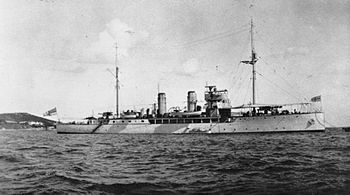HMS Foxglove
 HMS Foxglove during World War I
| |
| History | |
|---|---|
| Name | HMS Foxglove |
| Namesake | The foxglove |
| Builder | Barclay Curle, Glasgow, Scotland |
| Launched | 30 March 1915 |
| Commissioned | 1915 |
| Fate | Sold for scrapping 7 September 1946 |
| General characteristics | |
| Type | Template:Sclass- minesweeping sloop |
| Displacement | 1,200 tons |
| Length | |
| Beam | 33 ft (10 m) |
| Draught | 12 ft (3.7 m) |
| Propulsion |
|
| Speed | Designed for 1,400 or 1,800 hp to make 17 knots (31 km/h), but actually required about 2200 indicated horsepower for this speed |
| Range | 2,000 nmi (3,700 km) at 15 kn (28 km/h) with max. 250 tons of coal |
| Complement | 77 |
| Armament | Designed to mount 2 × 12-pdr (76 mm) guns and 2 × 3 pdr (47 mm) AA guns, but with wide variations |
HMS Foxglove was an Template:Sclass- minesweeping sloop of the Royal Navy built at Glasgow, Scotland, by Barclay Curle and launched on 30 March 1915.[1][2] She entered service later that year. During World War I, she and the other Acacia-class sloops were used almost exclusively for minesweeping duties until 1917, when the Royal Navy began to use them as convoy escorts, a task to which they were well suited.[2]
Service in Chinese waters
Foxglove served on the China Station during the early 1920s.[3] In 1921, she joined the Royal Navy light cruiser Carlisle and the commercial steamer SS Shansi in rescuing survivors of the passenger steamship SS Hong Moh, which had wrecked on 3 March 1921 near Swatow, China, with a loss of around 1,000 lives; Carlisle rescued 221 survivors, while Shansi saved 45 and Foxglove 28.[4]
World War II
Foxglove was one of only two Acacia-class sloops to survive long enough to see service in World War II.[2] She became a loss when she was dive-bombed and badly damaged by German aircraft off the Isle of Wight on 9 July 1940. She remained afloat, and was converted into an accommodation ship and base ship.[5] In this new role, she became a harbour guard ship in 1941,[1] serving at Londonderry (also known as Derry) in Northern Ireland for the remainder of World War II.[6]
Fate
The last surviving Acacia-class sloop,[2] Foxglove was sold for scrapping on 7 September 1946. She was scrapped at Troon, Scotland.[1]
Legacy
Foxglove's logbook is among those that was selected for digitisation as part of the online Old Weather project.[7]
Notes
- ^ a b c Colledge, p. 142.
- ^ a b c d Conway's All The World's Fighting Ships 1906-1921, p. 94.
- ^ "Royal Navy Log Books of the World War 1 Era - An Old Weather Citizen History Project". naval-history.net. Retrieved 3 May 2015.
- ^ Maritime Connector: Passenger Ship Incidents Archived 2010-09-24 at the Wayback Machine
- ^ "HMS Foxglove". Clydebuilt Database Shipping Times. Retrieved 3 May 2015.
- ^ "Radio Foyle People's War". BBC Radio. Retrieved 3 May 2015.
- ^ Old Weather
References
- Colledge, J. J. Ships of the Royal Navy: The Complete Record of All Fighting Ships of the Royal Navy From the Fifteenth Century To the Present. Annapolis, Maryland: Naval Institute Press, 1987. ISBN 0-87021-652-X.
- Gray, Randal, ed. Conway's All The World's Fighting Ships 1906-1921. Annapolis, Maryland: Naval Institute Press, 1985. ISBN 0-87021-907-3.
- BBC Radio Foyle People's War.
- Clydebuilt Database Shipping Times.
- Maritime Connector: Passenger Ship Incidents.
